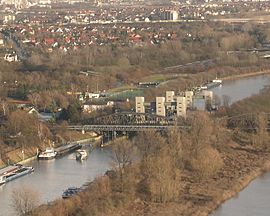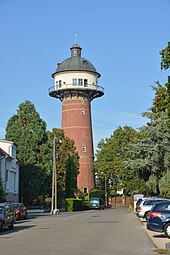Feudenheim
|
Feudenheim
City of Mannheim
|
|
|---|---|
| Coordinates: 49 ° 29 ′ 11 ″ N , 8 ° 32 ′ 0 ″ E | |
| Area : | 6.07 km² |
| Residents : | 14,688 (Dec. 31, 2017) |
| Population density : | 2,420 inhabitants / km² |
| Incorporation : | January 1, 1910 |
| Postal code : | 68259 |
| Area code : | 0621 |

Feudenheim is a district of Mannheim in the Rhine-Neckar triangle in Baden-Württemberg and also forms the Feudenheim district .
geography
Feudenheim is in the east of Mannheim on the Neckar . Neighboring districts are Wallstadt , Vogelstang , Käfertal , Neckarstadt-Ost and Neuostheim . To the east is Ilvesheim , which belongs to the Rhein-Neckar district . Feudenheim is on the Bertha Benz Memorial Route .
history
historical development
Feudenheim was first mentioned in the Lorsch Codex in 766 as Vitenheim (home of Vito). In the 9th century the church and two courtyards belonged to the Weißenburg monastery . Around 940 the sphere of influence had shifted to the Hochstift Worms . Before 1200, Feudenheim came to the Count Palatine Konrad von Staufen . The Neckar ferry can be identified for the first time in 1476. In 1615 the Neckar bend was shortened by a new river bed through the Au. During the Thirty Years War , Feudenheim was destroyed twice in 1621 and 1639. In 1632 the Gasthaus zum Ochsen was built. Today it is the oldest inn in Mannheim. During the Palatinate War of Succession , more than 70 buildings in Feudenheim were destroyed in 1689. A flood of the century devastated the lower lying areas of Feudenheim in 1784. The mouth of the Neckar was frozen over so that the water could not drain away. By 1795 the course of the river was corrected and brought to its current bed.
With the dissolution of the Electoral Palatinate , Feudenheim came to the Grand Duchy of Baden in 1803 . The synagogue was opened in 1813 and the Jewish community grew to 120 members by 1852. In 1863 Feudenheim was assigned to the Mannheim District Office. In the following years the orientation towards the nearby city grew. The industry-free Feudenheim was a popular place to live for wealthy Mannheimers as well as many workers. In 1874 the road to Mannheim was built, in 1883/84 the first steam tram was built by Martin Lutz & Cie. built and opened. In 1889 the Protestant Johanneskirche was consecrated. In 1905, Feudenheim sold a 40 hectare site south of the Neckar to the Süddeutsche Disconto-Gesellschaft to develop a residential area, from which Neuostheim developed. The water tower was completed a year later. In 1910, Feudenheim was incorporated into Mannheim, which electrified the tram in 1914. In the 1920s, the Neckar was canalized and the Feudenheim lock was built. During the November pogroms in 1938 , the Feudenheim synagogue was destroyed on November 10th. After the outbreak of the Second World War , the 14 remaining Jewish people from Feudenheim were deported to Camp de Gurs as part of the Wagner-Bürckel campaign on October 22, 1940 . The bunker was built in 1941 and with a capacity for 7,000 people it was one of the largest in the German Reich. Feudenheim survived the war relatively unscathed, so that a large part of the residential buildings was seized by the US Army.
In 1966 Feudenheim celebrated its 1200th anniversary. In 1972 the Carlo-Schmid-Brücke was built over the Neckar, and in 1979 the culture hall was opened. In 1986 the Mulberry Island and the Wörthel , which were created by the construction of the side canal and since then have provided a natural habitat for a variety of plants and animals, were elevated to a nature reserve . Also worth mentioning is the public park with the Bell natural monument , which was created in recent years .
The lost village of Dornheim
In what is now the Feudenheim district - around the Aubuckel - was the abandoned village of Dornheim, which was formerly independent of Feudenheim and was mentioned several times in the Lorsch Codex (also from 766) in the 8th and 9th centuries . It was last mentioned in a document in 1287, when the Count Palatine of the Rhine, Ludwig the Strict , gave Rheinhausen Castle and the associated towns of Dornheim and Mannheim as a morning gift to his son's fiancée from his second marriage, Princess Elisabetha of Lorraine . It is not known exactly when and why Dornheim was given up. It can be assumed that it was destroyed by the great Neckar flood in 1278, when the river shifted its bed north of Mannheim. Its district was shared by the villages of Käfertal and Mannheim and had been in dispute over this for centuries.
Population development
|
|
|
mayor
|
Politics, administration
According to the main statute of the city of Mannheim, each city district has a district advisory council, which includes 12 residents who are appointed by the local council according to the results of the local council election. They are to be heard on important matters that affect the municipality and advise the local administration and committees of the municipal council.
| Political party | 2019 | 2014 | 2009 | 2004 | 1999 | 1994 |
|---|---|---|---|---|---|---|
| CDU | 3 | 3 | 4th | 5 | 7th | 5 |
| GREEN | 3 | 2 | 2 | 2 | 1 | 2 |
| SPD | 2 | 3 | 4th | 4th | 3 | 4th |
| The left | 1 | 1 | 0 | 0 | 0 | 0 |
| Mannheim list | 1 | 1 | 1 | 1 | 1 | 1 |
| FDP | 1 | 1 | 1 | 0 | 0 | 0 |
| AfD | 1 | 1 | 0 | 0 | 0 | 0 |
As one of the eleven outer city districts, Feudenheim has a municipal secretariat, which is responsible for local administrative tasks.
Culture and sights
Buildings
The Gasthaus zum Ochsen is the oldest inn in Mannheim. It was built in 1632 by the cent Schöffen Gangolf Back and was then the Feudenheim post office .
The Catholic St. Peter and Paul Church has a Gothic tower, a baroque nave and a Saxon transept according to the history of its origins . The Protestant Johanneskirche was built in 1889 according to plans by Hermann Behaghel in neo-Gothic style. The also Protestant Epiphany Church dates from 1965.
The water tower , the landmark of Feudenheim, was built in 1906. Similar towers from the same period can be found in the neighboring towns of Wallstadt and Straßenheim. The Feudenheim lock in a sober, businesslike style was built in the 1920s.
The Jewish cemetery in Feudenheim was laid out on Scheffelstrasse in 1858 and used until 1900. Today there are 53 tombstones left . The cemetery is a protected cultural monument .
The Feudenheim lock and the associated hydroelectric power station are located in the Neckar area .
Events
Every year the Feidemer Kerwe takes place on the third weekend in October . The main street of Feudenheim is largely a pedestrian zone and invites you to celebrate with rides, three street stages and all kinds of culinary delicacies. Furthermore, the town festival and the Christmas market take place at the town hall every year.
Feudenheim Carnival
There are three carnival clubs in Feudenheim. The women's carnival in Feudenheim, the Narrebloos Prinz Max and the Carnival Society Lallehaag.
Several ceremonial meetings of the clubs take place every year. There is also a service on the Sunday before Rose Monday in the Catholic Church of St. Peter and Paul. The highlight of the Feudenheim Carnival is the parade across the town, which takes place every year on Carnival Tuesday.
Sports
There is a skate park in the nearby Bürgerpark.
Economy and Infrastructure
The range of shops and services in mainly family-run businesses covers all areas of need. There is also a weekly market at the town hall on Fridays. There are seven day-care centers for children and young people in the district, a primary school, a secondary school and a grammar school.
Personalities
- Carl Metz (1818–1877), engineer and entrepreneur
- Martin Lutz (1833–1913), council clerk and entrepreneur (steam tram pioneer and honorary citizen)
- Max Enderlin (1872–1940), Rector at the Feudenheim School 1915–1933
- Adam Massinger (1888–1914), German astronomer
- Alfred Rapp (1933–2011), politician (CDU), city councilor 1975–1994, previously a district adviser
- Ümit Davala (* 1973), former professional soccer player and today's coach. In his youth he played for ASV Feudenheim
literature
- Wilhelm Schaaff: Home history of Feudenheim . Mannheim 1958
- Citizens' Community (Ed.): 1200 Years of Feudenheim 766–1966 . Mannheim 1966
- Günther Löhr: Feudenheimer community history . Mannheim 1980
- History workshop Feudenheim / Michael Caroli: Feudenheim: Illustrated history of a Mannheim suburb . Mannheim 1991, ISBN 3-923003-53-6
- Stephanie Hoffmann: The late Hallstatt - early La Tène settlement of Mannheim-Feudenheim . Grin Verlag May 2008, ISBN 3-638-93086-6
- Rudolf Kreutzer: Local family book Feudenheim 1650 - 1900 . Mannheim: Waldkirch 2008, ISBN 978-3-927455-53-5 (= Badische Ortssippenbücher 133)
Individual evidence
- ^ City of Mannheim: 2017 population in a small-scale breakdown. (PDF 2.26 MB) Statistical data Mannheim № 1/2018. May 14, 2019, p. 5 ff. , Accessed on May 14, 2019 .
- ↑ Minst, Karl Josef [transl.]: Lorscher Codex (Volume 2), Certificate 516 November 18, 776 - Reg. 93. In: Heidelberger historical stocks - digital. Heidelberg University Library, p. 180 , accessed on April 19, 2015 .
- ↑ Minst, Karl Josef [transl.]: Lorscher Codex (Volume 2), Certificate 536, May 28, 766 - Reg. 53. In: Heidelberg historical stocks - digital. Heidelberg University Library, p. 191 , accessed on February 18, 2016 .
- ↑ Mention of Dornheim in the Lorsch Codex. In: Archivum Laureshamense - digital. Heidelberg University Library, accessed on January 29, 2016 .
- ^ JG Rieger: Historical-topographical-statistical description of Mannheim and its surroundings , 1824, p. 9 ( limited preview in the Google book search).
- ^ Hansjörg Probst : Neckarau Volume 1: From the beginnings to the 18th century . Mannheim 1988, ISBN 3-87804-191-8 , in Heidelberg historical holdings - digital, Heidelberg University Library, p. 157, accessed on February 24, 2016.
- ^ Chronicle of the city of Mannheim - milestones up to the 13th century. City of Mannheim, accessed on January 29, 2016 .
- ↑ a b Main Statute of the City of Mannheim. (PDF 234 kB) VII. City districts and district councils, § 22. City of Mannheim, April 28, 2009, p. 10 , accessed on April 10, 2018 .
- ↑ SessionNet | City of Mannheim District Advisory Board Feudenheim. Retrieved November 6, 2019 .
- ↑ SessionNet | City of Mannheim District Advisory Board Feudenheim. Retrieved November 6, 2019 .
Web links
- City of Mannheim: District life, Feudenheim. Retrieved October 25, 2014 .
- City of Mannheim: Statistical data 2015, Feudenheim. (PDF 209 kB) December 31, 2014, accessed on September 21, 2014 .
- Feudenheim-Net
- Pictures and history of Feudenheim
- Lower Neckar nature reserve - Mulberry Island






